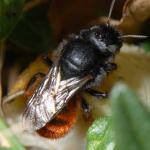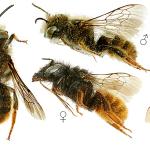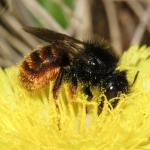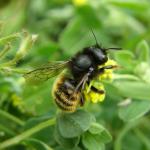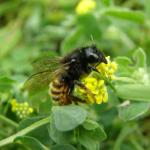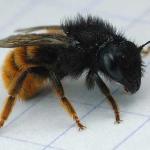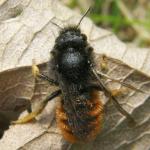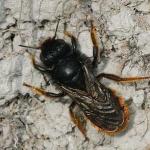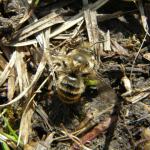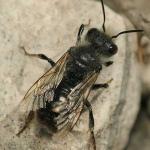Apis rustica GEOFFROY 1785; Apis fusca CHRIST 1791 (nec. SCOPOLI 1763); Apis fuscescens VILLERS 1789; Apis hirundinaria CHRIST 1791; Osmia pyrenaea LEPELETIER 1841; Osmia fusca GISTEL 1857; Osmia rufitarsis SMITH 1879; Osmia monachiensis STRAND 1917
The males of this species are among the first of the solitary bees to appear in the spring, with one exceptional record as early as late February. They are shortly followed by the distinctive females.
Distributed predominantly in southern England and south Wales, the range being closely correlated with chalk and limestone soils. This is a predominantly central European species, becoming rare and sporadic north of Belgium. The Palaearctic range extends from southern Finland (one record only (Elfving, 1968)) to Spain, and east to the former Yugoslavia and Romania. Stoeckhert (1933) records the species from central Asia and reports that both there and in southern Europe it is largely restricted to montane sites.
Classified as a Nationally Notable (Nb) species by Falk (1991).
Generally calcareous grassland and open deciduous woodland on chalk and limestone soils.
Univoltine; April to early July. The males are very short-lived in comparison with the females.
Females establish their nests in empty snail shells, including those of Helix pomatia, Cepaea nemoralis, C. hortensis and Monacha cantiana. Nests contain about four or five cells, depending on the size of shell used. Cell partitions and the closing plug consist of leaf mastic (i.e. masticated portions of green leaf). The space between the last cell partition and the closing plug is filled with a rubble containing very small snail shells and pieces of chalk, or soil. When the nest is completed the female covers the shell with a mound of dead grass stems, beech scales or leaf fragments (Perkins, 1884, 1891; G R Else, pers. obs.). The reason for this behaviour is not known, but it may camouflage the nest from possible parasites and predators at a time when it may be vulnerable to such attack. Nests are illustrated by Geiser (1988) and Westrich (1989). Males have been found sheltering in empty snail shells during periods of inclement weather (G R Else, pers. obs.).
Wood anemone (Anemone nemorosa), bluebell (Hyacinthoides non-scripta), heath dog-violet (Viola canina), bird's-foot-trefoil (Lotus corniculatus), horseshoe vetch (Hippocrepis comosa), sainfoin (Onobrychis viciifolia), sallow (Salix spp.), ground-ivy (Glechoma hederacea), daisy (Bellis perennis) and dandelion (Taraxacum sp.).
No information available.
Profile written: 1998
Proofed: February 2012


